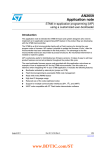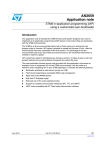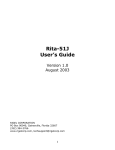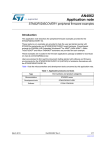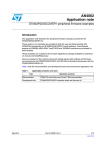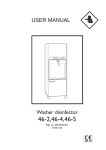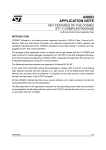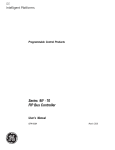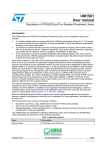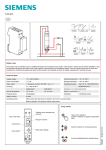Download STM8S in-application programming (IAP) using a customized
Transcript
AN2659
Application note
STM8S in-application programming (IAP)
using a customized bootloader
Introduction
This application note is intended for STM8 firmware and system designers who need to
implement an In-Application Programming (IAP) feature in the product they are developing
with the STM8S microcontroller.
The STM8S is an 8-bit microcontroller family with Flash memory for user program code or
firmware.
IAP makes it possible to update the firmware ‘in situ’, after the microcontroller has been
embedded in the final product. The advantage is that the microcontroller board can stay
inside its product enclosure, no mechanical intervention is needed to do the update.
IAP is extremely useful for distributing new firmware versions. It makes it easy to add new
product features and correct problems throughout the product life cycle.
The bootloader firmware source code provided with this application note shows an example
of how to implement IAP for the STM8 microcontroller. You can use this code as a reference
when integrating IAP in your STM8 application.
February 2009
Rev 1
1/18
www.st.com
Contents
AN2659
Contents
1
Theory of operation . . . . . . . . . . . . . . . . . . . . . . . . . . . . . . . . . . . . . . . . . 3
1.1
Block versus word programming . . . . . . . . . . . . . . . . . . . . . . . . . . . . . . . . 3
1.2
RAM versus Flash programming code location . . . . . . . . . . . . . . . . . . . . . 3
1.2.1
2
1.3
Flash memory protection, bootloader . . . . . . . . . . . . . . . . . . . . . . . . . . . . . 4
1.4
Library support for Flash programming . . . . . . . . . . . . . . . . . . . . . . . . . . . 5
Library support for IAP . . . . . . . . . . . . . . . . . . . . . . . . . . . . . . . . . . . . . . . 6
2.1
3
5
6
2/18
Description how to compile/link code into RAM address locations . . . . . . 8
STM8 devices with boot ROM - built-in IAP implementation . . . . . . . . 10
4.1
Implementation details . . . . . . . . . . . . . . . . . . . . . . . . . . . . . . . . . . . . . . . 10
4.2
Bootloader protocol . . . . . . . . . . . . . . . . . . . . . . . . . . . . . . . . . . . . . . . . . 10
Example of user bootloader application . . . . . . . . . . . . . . . . . . . . . . . . 11
5.1
Bootloader firmware description . . . . . . . . . . . . . . . . . . . . . . . . . . . . . . . . 11
5.2
Used library functions . . . . . . . . . . . . . . . . . . . . . . . . . . . . . . . . . . . . . . . . 14
5.3
Block programming - RAM code copy . . . . . . . . . . . . . . . . . . . . . . . . . . . 14
5.4
Interrupt vector table redirection . . . . . . . . . . . . . . . . . . . . . . . . . . . . . . . . 14
5.5
Bootloader overwrite protection . . . . . . . . . . . . . . . . . . . . . . . . . . . . . . . . 14
5.6
Used bootloader interface . . . . . . . . . . . . . . . . . . . . . . . . . . . . . . . . . . . . 14
Conclusion . . . . . . . . . . . . . . . . . . . . . . . . . . . . . . . . . . . . . . . . . . . . . . . . 16
6.1
7
Flash programming function list . . . . . . . . . . . . . . . . . . . . . . . . . . . . . . . . . 6
Compiler support (Cosmic) for RAM code execution . . . . . . . . . . . . . . 8
3.1
4
Programming the data EEPROM area . . . . . . . . . . . . . . . . . . . . . . . . . . . 4
Features in final bootloader application . . . . . . . . . . . . . . . . . . . . . . . . . . 16
Revision history . . . . . . . . . . . . . . . . . . . . . . . . . . . . . . . . . . . . . . . . . . . 17
AN2659
1
Theory of operation
Theory of operation
In practice, IAP (In Application Programming) requires a bootloader implemented in the
STM8 firmware that can communicate with an external master (such as a PC) via a suitable
communications interface. The new code can be downloaded into the microcontroller
through this interface. The microcontroller then programs this code into its Flash memory.
The STM8 microcontroller family has IAP support in hardware. The software library
available for the STM8 family contains support for IAP programming. This simplifies
implementation of IAP in the end-user application.
IAP programming can also be used to update the content of the internal Data EEPROM
memory, and the internal RAM memory.
Figure 1.
Typical bootloader application
STM8 board
STM8
RS232
RS232/TTL
converter
bootloader enable jumper
PC
1.1
Block versus word programming
STM8 family microcontrollers contain Flash type program memory where firmware can
write. There are two methods for writing (or erasing) Flash program memory:
●
●
1.2
Byte/word programming (1 or 4 bytes)
–
Advantages: offers small area programming, programming is done from Flash
–
Disadvantages: program stops during programming, programming speed is slow
Block programming (128 bytes - or one Flash block for a given STM8 type)
–
Advantages: offers large area programming with high speed (large blocks)
–
Disadvantages: programming routine must run from RAM (need to copy
programming routine into RAM)
RAM versus Flash programming code location
Depending on the selected programming method (see 1.1: Block versus word programming)
the programming code must run from RAM or from Flash memory.
If the programming code runs from Flash, then we can use only word/byte programming to
program the Flash memory. During Flash memory programming, the code cannot access
the Flash memory (Flash is in programming mode). Therefore program execution from Flash
is stopped during programming (for several milliseconds) and then continues. This mode is
useful in cases where only a small part (a few bytes) of Flash memory need to be updated
or when it does not matter that programming is (very) slow.
3/18
Theory of operation
AN2659
To program a large Flash memory area with optimum speed then we should use block
programming mode. Block programming mode can be performed only by code located in
RAM. First we must copy the programming code into RAM and then run (jump to) this code.
The RAM code then uses block mode to program the Flash. In this mode, programming one
block takes the same time as programming one byte/word in byte/word mode. As a result
programming speed is very fast and code execution is not stopped (because it is running
from RAM). The only disadvantage of this method is the RAM code management:
1.2.1
–
Copying the executable code to RAM
–
Storing the RAM code (usually stored in Flash - but can be downloaded from
outside)
–
Allocating RAM space for code
–
Compiling the code to be able to run from RAM
Programming the data EEPROM area
In case of data EEPROM programming, the programming code does not have to be
executed from RAM. It can be located in Flash program memory, even if block programming
is used. This Read-While-Write (RWW) feature speeds up microcontroller performance
during IAP. Only the data loading phase must execute from RAM - this is the part of code
which loads data into the EEPROM buffer. However during the physical programming phase
(which takes several milliseconds) the code runs from Flash while the data EEPROM
memory is programmed in the background. Completion of data EEPROM programming is
indicated by a flag. An interrupt can be generated when the flag is set.
1.3
Flash memory protection, bootloader
To avoid accidental overwriting of Flash code memory (for example in the case of a firmware
crash) several levels of write protection are implemented in the STM8 microcontroller family.
After an STM8 reset, write access to Flash memory is disabled. To enable it, firmware must
write 2 unlock keys in a dedicated register. If the unlock keys are correct (0x56, 0xAE) then
write access to Flash memory is enabled and it is possible to program Flash memory using
either byte/word or block programming mode. If the unlock keys are incorrect, then write
access to Flash memory is disabled until the next device reset. After writing to Flash
memory, it is recommended to enable write protection again by clearing a specific bit in the
Flash control register (to avoid accidental write).
A similar protection mechanism exists for Data EEPROM memory, with a specific unlock
register and unlock keys (0xAE, 0x56).
Additional write protection exists for programming code itself, to avoid overwriting critical
code. It is designed to protect the bootloader code from being overwritten during IAP. The
STM8 family has a user boot code (UBC) area which is permanently write protected. This
UBC area starts from the Flash memory start address (0x8000) and its size can be changed
by option byte. The boot code area includes the interrupt vector table (0x8000 - 0x8080), so
to allow for modification of the vector table via IAP, the main vector table should be
redirected to another vector table located in the rewritable application code area. See Figure
2. for memory map locations and dependencies.
4/18
AN2659
Theory of operation
Figure 2.
User boot code area and User application area
Address
Content
0x6000
ROM code
redirection
...
0x8000
interrupt vector table
0x8080
bootloader start
...
...
...
...
...
...
...
bootloader end
0x9000
user interrupt table
0x9080
user code start
...
...
...
...
...
...
...
user code end
...
free space
...
...
...
...
UBC
User boot code area
defined by option byte
User
application
area
More detailed information about memory map of particular STM8 device type can be found
in STM8 Reference manual and datasheet.
1.4
Library support for Flash programming
The STM8 firmware library, available from st.com, provides developed and verified functions
for programming Flash memory. Those functions supports byte/word and block
programming. These library functions make it easier for developers to write their
programming code. The library also includes functions for managing the programming code
in RAM: copy to RAM, execution from RAM, storing functions in Flash memory.
The STM8 library package also contains examples that show how to use these functions in
the final source code. You can write your own code based on these examples.
5/18
Library support for IAP
2
AN2659
Library support for IAP
STM8 library contains modules for Flash programming. These are contained in the following
files:
\FWLib\library\src\stm8s_flash.c
\FWLib\library\inc\stm8s_flash.h
\FWLib\library\inc\stm8s_map.h
Here you can find the complete source code for Flash programming. Refer to the library user
manual, \FWLib\stm8s_fwlib_um.chm, for help on using STM8 library.
2.1
Flash programming function list
This list gives a short description of the STM8S Flash programming functions:
void FLASH_DeInit ( void )
Deinitializes the FLASH peripheral registers to their default reset values.
void FLASH_EraseBlock ( u16 BlockNum, FLASH_MemType_TypeDef MemType )
Erases a block in the program or data EEPROM memory.
void FLASH_EraseByte ( u32 Address )
Erases one byte in the program or data EEPROM memory.
void FLASH_EraseOptionByte ( u32 Address )
Erases an option byte.
u32 FLASH_GetBootSize ( void )
Returns the Boot memory size in bytes.
FlagStatus FLASH_GetFlagStatus ( FLASH_Flag_TypeDef FLASH_FLAG )
Checks whether the specified Flash flag is set or not.
FLASH_LPMode_TypeDef FLASH_GetLowPowerMode ( void )
Returns the Flash behavior type in low power mode.
FLASH_ProgramTime_TypeDef FLASH_GetProgrammingTime ( void )
Returns the fixed programming time.
void FLASH_ITConfig ( FunctionalState NewState )
Enables or Disables the Flash interrupt mode.
void FLASH_Lock ( FLASH_MemType_TypeDef MemType )
Locks the program or data EEPROM memory.
void FLASH_ProgramBlock ( u16 BlockNum, FLASH_MemType_TypeDef MemType,
FLASH_ProgramMode_TypeDef ProgMode, u8 * Buffer )
Programs a memory block.
void FLASH_ProgramByte ( u32 Address, u8 Data )
Programs one byte in program or data EEPROM memory.
void FLASH_ProgramOptionByte ( u32 Address, u8 Data )
Programs an option byte.
6/18
AN2659
Library support for IAP
void FLASH_ProgramWord ( u32 Address, u32 Data )
Programs one word (4 bytes) in program or data EEPROM memory.
u8 FLASH_ReadByte ( u32 Address )
Reads any byte from Flash memory.
u16 FLASH_ReadOptionByte ( u32 Address )
Reads one option byte.
void FLASH_SetLowPowerMode ( FLASH_LPMode_TypeDef LPMode )
Select the Flash behavior in low power mode.
void FLASH_SetProgrammingTime ( FLASH_ProgramTime_TypeDef ProgTime )
Sets the fixed programming time.
void FLASH_Unlock ( FLASH_MemType_TypeDef MemType )
Unlocks the program or data EEPROM memory.
FLASH_Status_TypeDef FLASH_WaitForLastOperation ( FLASH_MemType_TypeDef
MemType )
Wait for a Flash operation to complete.
7/18
Compiler support (Cosmic) for RAM code execution
3
AN2659
Compiler support (Cosmic) for RAM code execution
As mentioned above, block programming must be executed from RAM memory. Therefore
the code to be copied into RAM must be compiled and linked to be run in RAM address
space but stored in Flash memory.
It is possible to write simple programming code assembly, taking care with the RAM
addressing and then storing this code in Flash (e.g. code uses only relative addressing or
RAM addresses). However it is more efficient to use compiler support for this purpose.
Cosmic compiler support (described below) has these features built-in.
3.1
Description how to compile/link code into RAM address
locations
This option is performed (in Cosmic compiler) by creating a special memory segment which
is defined in the linker file (*.lkf) and marked by flag “-ic” . For example (RAM space
segments definition in linker file):
# Segment Ram:
+seg .data -b 0x100 -m 0x500 -n .data
+seg .bss -a .data -n .bss
+seg .E_W_ROUTs -a .bss -n bootcode -ic
This defines a RAM space from address 0x100. Firstly the .data and .bss sections are
defined. Then it defines a moveable .E_W_ROUTs section where the routines for Flash
memory erase and write operations will be located. This section must be marked by option
“-ic” (moveable code).
Into “-ic” marked section we put functions which should be compiled/linked for RAM
execution but stored in Flash memory. This is done in source code by section definition, for
example:
...
//set code section to E_W_ROUTs placement
#pragma section (E_W_ROUTs)
void FlashWrite(void)
{
...
}
void FlashErase(void)
{
...
}
//set back code section to default placement
#pragma section ()
...
8/18
AN2659
Compiler support (Cosmic) for RAM code execution
Now the “FlashWrite()” and “FlashErase()” functions will be compiled and linked for RAM
execution (in section “E_W_ROUTs”) but their code will be placed in Flash memory - just
after the“.text” and “.init” sections. This can seen from the generated map file:
Example of final map file:
start
start
start
start
start
start
start
start
start
start
start
00008080
00000000
00000000
00000003
00000098
00000100
00000100
00000100
00008510
00008000
00008500
end
end
end
end
end
end
end
end
end
end
end
00008500
00000000
00000003
00000098
00000098
00000100
00000100
000001F0
00008600
00008080
00008510
-------Segments
-------length 1152
length
0
length
3
length
149
length
0
length
0
length
0
length
240
length
240
length
128
length
16
segment
segment
segment
segment
segment
segment
segment
segment
segment
segment
segment
.text
.bsct
.ubsct
.RAM
.share
.data
.bss
.E_W_ROUTs, initialized
.E_W_ROUTs, from
.const
.init
The map file shows the location of the “E_W_ROUTs” sections. One for storage in Flash (in
map file marked as “from”) and one for execution (in map file marked as “initialized”).
Finally the microcontroller firmware must copy these sections from Flash to RAM before
calling the RAM functions. Cosmic compiler support this copying by a built-in function “int
_fctcpy(char name)” which copies a whole section from a source location in Flash to a
destination location in RAM. For example:
void main(void)
{
...
//copy programming routines to Flash
_fctcpy('b');
/* Define flash programming Time*/
FLASH_SetProgrammingTime(FLASH_PROGRAMTIME_STANDARD);
/* Unlock Program & Data memories */
FLASH_Unlock(FLASH_MEMTYPE_DATA);
FLASH_Unlock(FLASH_MEMTYPE_PROG);
/* Fill the buffer in RAM */
for (i = 0; i < FLASH_BLOCK_SIZE; i++) GBuffer[i] = new_val2;
/* Program the block 0*/
block = 0; /*block 0 is first block of Data memory: address is 4000*/
FLASH_ProgramBlock(block, FL_MEMTYPE_PROG, FL_PRGMODE_STD, GBuffer);
...
}
As shown in the example above, just after the program starts, the RAM section is copied
from Flash into RAM by the function “_fctcpy('b')”. The function parameter ‘b’ is the first
character of the section name defined in the linker file (“b” as “bootcode” - see linker file on
page 8) .
The firmware then can call any of the FLASH_xxx() functions in RAM.
Execution is then done from RAM.
9/18
STM8 devices with boot ROM - built-in IAP implementation
4
AN2659
STM8 devices with boot ROM - built-in IAP
implementation
Some but not all STM8 devices have an internal Boot ROM memory which contains a
bootloader and thus already have a built in IAP implementation. So the IAP example
described in this application note is primarily intended for STM8 devices that have no Boot
ROM.
4.1
Implementation details
The built-in bootloader in BootROM is fixed (not rewritable) and is specific for each STM8
type. The communication interface supported depends on the peripherals present in the
given STM8 type and if they are implemented in the bootloader. For example, some device
types support firmware download through UART and CAN, some device types support only
UART and others only SPI. Information concerning the supported interfaces can be found in
the relevant device datasheet.
Activation of the built-in bootloader is done by programming the BL[7:0] option byte
described in the datasheet. The Boot ROM bootloader checks this option byte and if
enabled then it runs it own code - waits for the host to send commands/data. If the BL[7:0]
option byte is inactive then the Boot ROM bootloader jumps to user reset address - 0x8000.
4.2
Bootloader protocol
To be able to download firmware into the device, the host and bootloader must communicate
through the same protocol. This bootloader protocol for STM8 devices is specified in the
“UM0560 - Bootloader user manual” available from http://www.st.com. This same protocol is
used in the firmware example provided with this application note. The UM0560 user manual
describes all the bootloader protocol properties: used interfaces, timeouts, command
formats, packet formats, error management, ... .
10/18
AN2659
5
Example of user bootloader application
Example of user bootloader application
This section describes a practical application of IAP programming with a user - implemented
bootloader.
A bootloader is the part of code which runs immediately after a microcontroller reset and
waits for an activation signal (for example from grounding a specific pin or receiving a token
from a communications interface).
If activation is successful then the code enters bootloader mode. If activation fails (for
example due to timeout, jumper on pin not present) then the bootloader jumps directly to the
user application code.
In bootloader mode, the bootloader communicates with the external master device through
a selected interface (UART, SPI, I2C, CAN, ...) using a set of commands. These commands
usually are write to Flash, erase Flash, verify Flash and some additional operations: read
memory, execute code from given address (jump to given address).
5.1
Bootloader firmware description
The following flow chart (Figure 3.: Bootloader flowchart) describes the basic program flow
of the bootloader application.
After device reset, the bootloader checks if it is activated by predefined I/O pin. This pin
works as bootloader activation signal and is connected via a jumper to ground. The
bootloader configures the I/O pin in input mode and activates the pull-up on the I/O port.
Then it checks the pin state. If the pin voltage level is zero (jumper present) then bootloader
is activated. Otherwise it jumps to the reset address of the user application (if this address is
valid).
If the bootloader is activated it then initializes the communication interface (UART1) in
receiver mode and starts a timeout count (e.g. 1 second). If during this timeout nothing is
received from UART1 then the bootloader jumps to the user application reset address (if
valid).
If the bootloader a valid activating token byte receives from UART1 before the timeout
elapses, it then enters memory management mode to perform the following operations:
1.
First the bootloader initializes the Flash programming routines by copying the
programming functions to RAM.
2.
Then bootloader waits in a loop for a valid command to be received from UART1.
3.
If valid command is received it is parsed and executed (Read, Write, Erase, Version
commands).
4.
If a Go command is received, then the bootloader jumps to the address given in the
command (from which can be returned or not depending on the code at the destination
address).
Commands have given format which is specified and must be followed by both sides:
bootloader and master. The command specification handles all possible cases and covers
error management. To make it easy to meet this specification while performing the more
complicated operations (for example, fill Flash memory from “*.s19” file), appropriate
software with a graphical user interface (GUI) has been written for the master side (usually
11/18
Example of user bootloader application
AN2659
PC). This GUI can perform all the specified commands. The command specification is
included with this Application Note as separate document.
12/18
AN2659
Example of user bootloader application
Figure 3.
Bootloader flowchart
Reset
Init I/O pin
(pull-up)
-
-
Valid user reset
vector?
IO pin in GND?
+
+
User application start
Init UART
Received token
in timeout interval?
-
+
Copy routines into RAM
Wait for command from UART
+
GO command?
(to run user code)
-
Jump to GO address
Parse commands
- WRITE
- ERASE
- READ
- VERSION
Perform command
13/18
Example of user bootloader application
5.2
AN2659
Used library functions
The code available with this application note uses STM8 software library functions by
including the appropriate files into projects. It uses not only the functions for Flash memory
programming management but also the functions for timer management (for example for
timeout counting), UART management (for communications with the master), GPIO
management (for configuring the I/O pin), clock management (to set up microcontroller and
peripheral speed).
The use of the library simplifies the development and makes the main source code simpler.
5.3
Block programming - RAM code copy
Copying the RAM code from Flash is done with Cosmic compiler support - by the built-in
function “_fctcpy()”. Copying is performed immediately after microcontroller reset - at the
beginning of the “main()” program function.
If another compiler is used, this would require a similar alternative solution for building RAM
routines.
5.4
Interrupt vector table redirection
The primary interrupt vector table is located in the UBC (User Boot Code) area which is
write protected. Interrupt table redirection has been implemented to allow the user
application to change the interrupt vectors.
Redirection is performed in the following way. The start of the user application area contains
its own interrupt table with the same format as the primary interrupt table, a set of jumps to
interrupt routines (the first table entry is the “user application reset”). The primary interrupt
table contains fixed vectors to this user interrupt table. So if an interrupt occurs then it is
redirected from the primary interrupt table to the user interrupt table by one jump.
The only requirement for the user application is that the user interrupt table must be located
at a fixed address because the primary interrupt table is not rewritable and jumps to the user
interrupt table at a fixed address). See Figure 2.: User boot code area and User application
area for details.
5.5
Bootloader overwrite protection
The bootloader area must be write protected. This protection is done by setting the UBC
option byte according to the bootloader size.
The user application area (which begins with the user interrupt vector table) starts in first
unprotected Flash sector after the UBC area.
Bootloader protection must be set by SWIM - usually during bootloader programming.
5.6
Used bootloader interface
The current version of the bootloader code supports UART as communication interface. In
future versions, other communication interfaces will be supported (SPI, I2C, CAN, LIN). The
14/18
AN2659
Example of user bootloader application
user application code then can be upgraded via the interface used by the target application
(for example, CAN in the case of an automotive system).
15/18
Conclusion
6
AN2659
Conclusion
The STM8 microcontroller has full support for IAP programming. It allows the internal STM8
firmware to erase and write to any of its internal memories: Flash program memory, data
EEPROM memory, RAM memory. The short programming times (inherent to the advanced
technology) can be further decreased by using of fast programming mode (if the destination
memory is erased). The STM8 RWW (Read While Write) feature allows the microcontroller
to stay at a high performance level even during Flash and/or EEPROM memory
programming.
The bootloader application presented here, provides designers with an IAP implementation
that they can use to add IAP support into their own final products. The bootloader code is
designed to run in STM8 family microcontrollers and uses the STM8 software library for
easier programming.
6.1
16/18
Features in final bootloader application
●
Bootloader activated by external pin (jumper on PCB)
●
Interrupt table redirection
●
Executable RAM code management
●
Library support for easier programming
●
Read While Write feature
●
High level C-language usage
●
In future: support for multiple communication interfaces
AN2659
7
Revision history
Revision history
Table 1.
Document revision history
Date
Revision
20-Feb-2009
1
Changes
Initial release
17/18
AN2659
Please Read Carefully:
Information in this document is provided solely in connection with ST products. STMicroelectronics NV and its subsidiaries (“ST”) reserve the
right to make changes, corrections, modifications or improvements, to this document, and the products and services described herein at any
time, without notice.
All ST products are sold pursuant to ST’s terms and conditions of sale.
Purchasers are solely responsible for the choice, selection and use of the ST products and services described herein, and ST assumes no
liability whatsoever relating to the choice, selection or use of the ST products and services described herein.
No license, express or implied, by estoppel or otherwise, to any intellectual property rights is granted under this document. If any part of this
document refers to any third party products or services it shall not be deemed a license grant by ST for the use of such third party products
or services, or any intellectual property contained therein or considered as a warranty covering the use in any manner whatsoever of such
third party products or services or any intellectual property contained therein.
UNLESS OTHERWISE SET FORTH IN ST’S TERMS AND CONDITIONS OF SALE ST DISCLAIMS ANY EXPRESS OR IMPLIED
WARRANTY WITH RESPECT TO THE USE AND/OR SALE OF ST PRODUCTS INCLUDING WITHOUT LIMITATION IMPLIED
WARRANTIES OF MERCHANTABILITY, FITNESS FOR A PARTICULAR PURPOSE (AND THEIR EQUIVALENTS UNDER THE LAWS
OF ANY JURISDICTION), OR INFRINGEMENT OF ANY PATENT, COPYRIGHT OR OTHER INTELLECTUAL PROPERTY RIGHT.
UNLESS EXPRESSLY APPROVED IN WRITING BY AN AUTHORIZED ST REPRESENTATIVE, ST PRODUCTS ARE NOT
RECOMMENDED, AUTHORIZED OR WARRANTED FOR USE IN MILITARY, AIR CRAFT, SPACE, LIFE SAVING, OR LIFE SUSTAINING
APPLICATIONS, NOR IN PRODUCTS OR SYSTEMS WHERE FAILURE OR MALFUNCTION MAY RESULT IN PERSONAL INJURY,
DEATH, OR SEVERE PROPERTY OR ENVIRONMENTAL DAMAGE. ST PRODUCTS WHICH ARE NOT SPECIFIED AS "AUTOMOTIVE
GRADE" MAY ONLY BE USED IN AUTOMOTIVE APPLICATIONS AT USER’S OWN RISK.
Resale of ST products with provisions different from the statements and/or technical features set forth in this document shall immediately void
any warranty granted by ST for the ST product or service described herein and shall not create or extend in any manner whatsoever, any
liability of ST.
ST and the ST logo are trademarks or registered trademarks of ST in various countries.
Information in this document supersedes and replaces all information previously supplied.
The ST logo is a registered trademark of STMicroelectronics. All other names are the property of their respective owners.
© 2009 STMicroelectronics - All rights reserved
STMicroelectronics group of companies
Australia - Belgium - Brazil - Canada - China - Czech Republic - Finland - France - Germany - Hong Kong - India - Israel - Italy - Japan Malaysia - Malta - Morocco - Singapore - Spain - Sweden - Switzerland - United Kingdom - United States of America
www.st.com
18/18


















